under eye fillers for wrinkles
Disastrous Outcomes: When Under Eye Filler Treatments Go Wrong
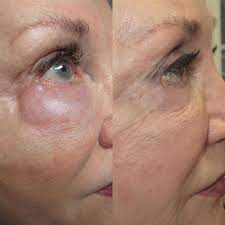
Is Tear Trough Filler wrong? We can fix it. Tear trough filler offers an aesthetic solution that can improve tired-looking eyes. These procedures have recently become increasingly popular with patients seeking quick, painless resolution of thigh hollows. Most tears use Hyaluronic Acid Fillers, which push in and strengthen skin barrier cells to help reduce inflammation and swelling. The system design prevents sun damage and other environmental pollutants.
One of the risks of getting under-eye fillers is that the filler can become visible under the skin, causing an uneven or lumpy appearance. The filler may also travel outside the treated area, resulting in an irregular or raised appearance. If you are considering getting under-eye fillers, consult a board-certified dermatologist or plastic surgeon with this treatment experience.
Under-eye fillers can help to reduce fine lines and wrinkles and help to improve the overall appearance of the skin. There are risks associated with this procedure, but there are also benefits. Under-eye fillers can only go right if administered by a qualified and experienced professional.
PROBLEMS WITH FILLERS UNDER THE EYES
Fillers are a popular treatment used to reduce wrinkles and fine lines. But while fillers can create a youthful look, they can also cause problems under the eyes.
Fillers injected into the wrong area can cause the delicate skin under the eyes to swell and bruise. In some cases, fillers can cause the eyes to bulge, giving a “puffy” look.
You must consult a reputable provider with experience performing the procedure to get fillers. Be sure to ask about the potential risks and side effects before you undergo any cosmetic treatment.
Under-eye fillers are a popular cosmetic procedure but have a few risks. The most significant risk is that the filler can migrate, causing lumps and bumps under the skin. Fillers can also cause bruising and swelling.
Despite these risks, under-eye fillers provide a quick and easy way to minimize the appearance of under-eye bags. Contact a cosmetic surgeon in your area for more information about reducing the appearance of under-eye bags.
THE WRONG TYPE OF FACIAL FILLER PRODUCT WAS USED FOR YOUR EYELID ANATOMY
If you receive a filler injection for your tear troughs and the product is unsuitable for your eyelid anatomy, you may experience some complications. The wrong type of filler injection can cause lumps, bruising, and tenderness in the injection area. It can also lead to difficulty closing your eyelids and decreased eye movement. In rare cases, the wrong type of filler injection can even cause blindness.
Fillers can sometimes cause bruising, swelling, and pain at the injection site. There’s a small risk of infection. However, fillers can last several months to a year, and the results are often immediate and very noticeable. Another, also there is no need for anesthesia or local anesthetic injections. Thus, while filler injection into the tear troughs is a reliable and efficient way to achieve a youthful appearance, specific risks, and benefits should be considered before this treatment.
If you are considering having your tear troughs filled with cosmetic injectables, you should consult a board-certified dermatologist or cosmetic surgeon knowledgeable in administering neuro ablative techniques. They can evaluate your needs and determine whether or not filler injections are right for you.
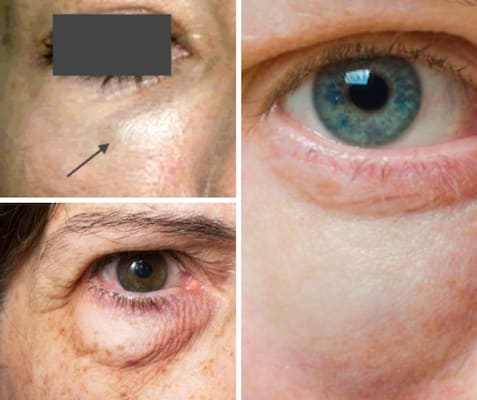
OCULOFACIAL PLASTIC SURGERY AND MEDICAL SPA
Oculofacial plastic surgery is specialized in correcting deformities and functional problems of the eye and facial region. It is a relatively new field of surgery, with many myths and misconceptions about it.
One of the most common myths about oculofacial plastic surgery is that it is purely cosmetic. However, this is not true. Oculofacial plastic surgery can correct functional problems, such as ptosis (drooping of the eyelid), and address cosmetic concerns, such as wrinkles or sun damage.
Another common misconception about oculofacial plastic surgery is that it is costly. However, the surgery cost varies depending on the procedure being performed. Some methods, such as lower eyelid surgery, are relatively inexpensive, while others, such as Botox injections, can be costly.
Finally, another myth about oculofacial plastic surgery is that it is only for wealthy people. This is also not true. Oculofacial plastic surgery can be performed on people of all income levels.
Oculofacial Plastic Surgery and Medical Spa is an excellent choice for improving the eyelid area. They offer various services, including Botox and fillers, and they have a team of experienced doctors who can help you achieve desired results.
Oculofacial Plastic Surgery and Medical Spa Services.
Oculofacial plastic surgery is a unique subspecialty that combines the knowledge and skills of ophthalmology and facial plastic surgery. Oculofacial surgeons are specially trained to diagnose and treat eyelids, orbits, and tear duct disorders. They also provide cosmetic procedures to help patients achieve a more youthful appearance.
Medical spa offers a full range of oculofacial plastic surgery and medical spa services. Surgeons are board-certified and have extensive experience in both cosmetic and reconstructive procedures. Provide various methods, including blepharoplasty, brow lift, and facial injectables. They also offer non-surgical treatments, such as facial rejuvenation and body contouring.
Medical Spa should be committed to providing patients with the highest quality of care. We offer a complete range of oculofacial plastic surgery and medical spa services. Surgeons are board-certified and have extensive experience in both cosmetic and reconstructive procedures.
Provide various methods, including blepharoplasty, brow lift, and facial injectables. Also offer non-surgical treatments,such as facial rejuvenation and body contouring.
What to expect during your consultation
Considering Oculofacial Plastic Surgery or a Medical Spa, knowing what to expect during your consultation is crucial and helps you make the best decision for your needs.
The doctor will assess your medical history and current condition during your consultation. They will also perform a physical examination. Based on this information, they can recommend the best treatment option.
After your consultation, you will be given time if you would like to proceed with treatment. The doctor will be happy to answer any of your questions you need to make an informed decision. Please do not hesitate if you have any questions.
The benefits of oculofacial plastic surgery.
Oculofacial plastic surgery is a type of surgery that can help smooth the eyes and facial appearance. It can correct defects or deformities and enhance the function of the eyes and face.
There are many benefits of oculofacial plastic surgery, including the following:
– Improvement in appearance
– Correction of defects or deformities
– Improvement in the function of the eyes and face
– Reduced risk of complications
– Reduced recovery time
However, oculofacial plastic surgery is a complex surgery with potential complications: infection, bleeding, and nerve damage. As with any surgery, patients should consult with their surgeon to discuss the risks and benefits of oculofacial plastic surgery.
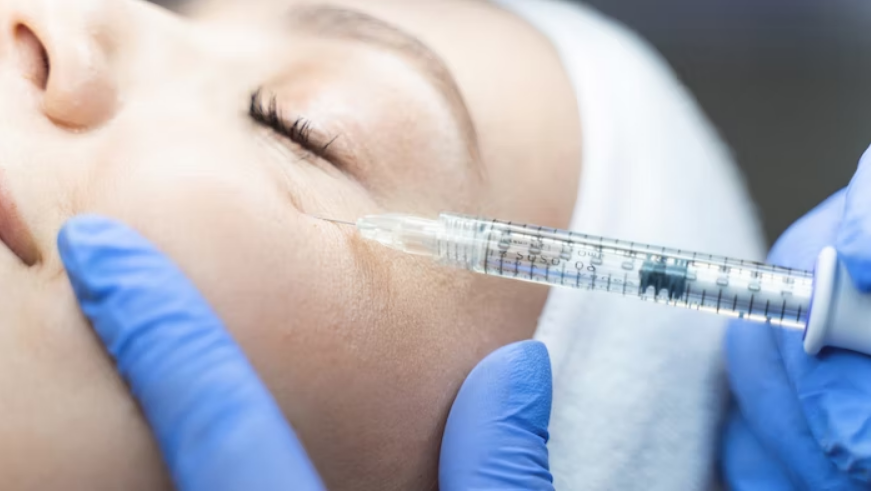
The risks of oculofacial plastic surgery.
Oculofacial plastic surgery is a relatively new and rapidly growing field of medicine. There are also many benefits to this type of surgery, also some potential risks that patients should be aware of.
The most common risks associated with oculofacial plastic surgery include infection, bleeding, scarring, and asymmetry. Other less common hazards include nerve damage, blindness, and vision loss.
As with any surgery, they were weighing the risks and benefits is crucial before proceeding. Patients should consult a qualified surgeon to ensure the procedure is proper.
Oculofacial plastic surgery and medical spa FAQs.
Below are some frequently asked questions about oculofacial plastic surgery and medical spas.
Q: What is oculofacial plastic surgery?
A: Oculofacial plastic surgery is a specialty that focuses on the correction of facial features and deformities around the eyes. This includes procedures such as eyelid surgery, browlift surgery, and orbitotomy.
Q: What is a medical spa?
A: A medical spa is a facility that offers non-invasive cosmetic treatments, such as Botox injections and laser skin resurfacing.
Q: What are the benefits of oculofacial plastic surgery?
A: Oculofacial plastic surgery can improve the face’s appearance and help correct facial deformities. It can also help to improve the function of the eyes.
Q: What are the risks of oculofacial plastic surgery?
A: As with any surgery, some risks are involved with oculofacial plastic surgery. These risks include bleeding, infection, and scarring.
Oculofacial plastic surgery is a type of surgery that deals with the correction of facial defects, deformities, and disfigurements. It is a specialized branch of plastic surgery that deals with the eyes, eyelids, eyebrows, and face.
The term “oculofacial plastic surgery” is a combination of the words “oculo,” meaning “eye,” and “facial,” meaning “face.” This type of surgery is also sometimes referred to as “oculoplastic surgery,” “eyelid surgery,” or “eyebrow surgery.”
Oculofacial plastic surgery can be performed for cosmetic reasons, to correct a congenital disability, or to repair damage from an accident or injury. In some cases, oculofacial plastic surgery may be covered by insurance.
There are a variety of different procedures that can be performed as part of oculofacial plastic surgery. Some of the more common methods include:
• Blepharoplasty: This surgical procedure removes excess skin and fat from the upper and lower eyelids. It can be performed for cosmetic reasons or to improve vision affected by drooping eyelids.
• Eyelid lift: This procedure is used to improve the appearance of drooping upper eyelids. It can also correct ptosis when the eyelid droops so far that it covers part of the pupil.
• Eyebrow lift: This procedure is used to improve the appearance of drooping eyebrows. It can also correct hypotrichosis when the eyebrows are too sparse.
• Rhinoplasty: This is a surgery to change the appearance of the nose for aesthetic reasons, functional reasons, or both.
• Otoplasty: This procedure improves the appearance of the ears. It can correct a congenital disability, reduce the size of large ears, or enhance the shape of the ears.
• Mole removal: This procedure removes moles, warts, and other skin growths. It can also improve the appearance of scars.
Oculofacial plastic surgery aims to improve the appearance of the eyes and face. In contrast, medical spas use a variety of treatments to enhance the appearance of the skin. The most common procedure is using an enzyme called hyaluronidase to break down the blood vessels that cause bruising and swelling between skin cells.
WHY IS TEAR TROUGH FILLER WRONG?
There is a growing trend of people getting tear trough filler to correct the appearance of dark circles under the eyes. However, this procedure has its risks. Here are a few reasons why tear trough filler may not be the best choice for you:
1. There is a risk of bruising and swelling.
2. There is a risk of infection.
3. There is a risk of the filler leaking into the surrounding tissue.
4. There is a risk of the filler migrating to other areas of the face.
5. There is a risk of the filler causing the eyes to look sunken in.
The procedure is relatively new, and there is still a lot we still need to learn about it. Unfortunately, some providers use an enzyme called hyaluronidase to break down the filler, which can cause serious side effects. Second, it is a delicate procedure; it can lead to severe complications if not done correctly.
Finally, it is an expensive procedure and is not covered by insurance. It is crucial to weigh the risks and benefits before making a decision.
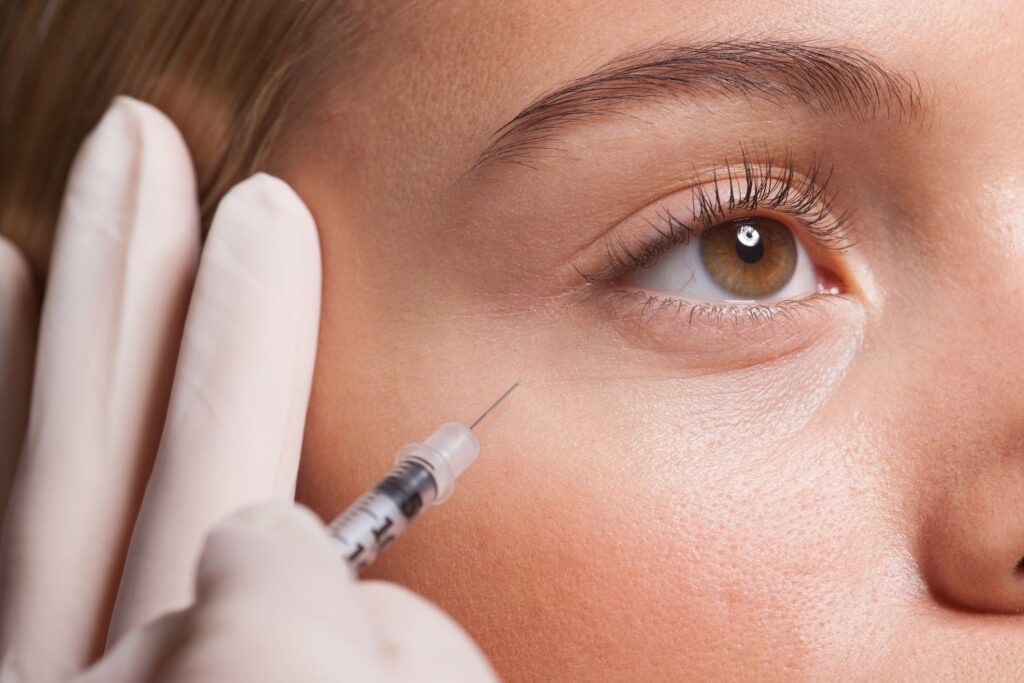
HOW SHOULD TEAR TROUGH FILLERS LOOK LIKE?
Tear trough fillers are designed to improve the area’s appearance under the eyes. They can help reduce the appearance of dark circles and Hollows and make the eyes look brighter and more youthful.
There are many types of tear trough fillers, and the best style for you will depend on your needs and goals. However, all tear trough fillers should be designed to produce a natural result.
There is no single answer; it’s difficult to say which one is right for you without knowing every individual’s facial anatomy is unique. However, tear trough fillers should ideally have specific characteristics for a natural look.
These include a smooth consistency, subtlety, and the ability to blend into the surrounding tissue. There are various types of tear trough fillers available on the market, so it is essential to consult a qualified medical professional who can help you choose the suitable filler and ensure that it is injected correctly.
YOUR EYELID OR FACIAL ANATOMY MAY NOT BE IDEAL FOR THIS PROCEDURE
These include a smooth consistency, subtlety, and the ability to blend into the surrounding tissue. There are various types of tear trough fillers available on the market, so it is essential to consult a qualified medical professional who can help you choose the suitable filler and ensure that it is injected correctly.
YOUR EYELID OR FACIAL ANATOMY MAY NOT BE IDEAL FOR THIS PROCEDURE
A good candidate for upper eyelid surgery has excess skin that hangs over the eyelashes and interferes with vision. The eyelid may also have a fatty deposit that gives the eyelid a puffy appearance.
Ideal candidates for upper eyelid surgery also have good facial anatomy. This means that the distance between the upper eyelid and the eyebrow is proportional to the rest of the face. The skin of the eyelid should have good elasticity so that it can heal well after surgery.
There are various reasons why an eyelid or facial anatomy may not be ideal for a procedure. In these cases, alternative methods may be necessary. Some alternatives include upper blepharoplasty, lower blepharoplasty, or a brow lift.
If you are considering these procedures, consult a qualified surgeon to discuss your options. While it is not definitively clear what went wrong in your case, it is generally agreed upon that the wrong type of facial filler products your eyelid anatomy. We strongly suggest that you avoid all facial fillers and developments for now.
HOW DO I FIND A RELIABLE CLINIC?
If you plan eyelid or facial anatomy surgery, you will want to find a reliable clinic you can trust. When searching for a healthcare clinic, some key factors and options can provide you with the necessary surgery.
First, you should ensure that the Joint Commission accredits the clinic on Accreditation of Healthcare Organizations (JCAHO). This is a gold standard when it comes to accreditation for healthcare organizations.
You should also ensure that the clinic has experience performing the type of surgery you want. You can ask for references from the clinic or look for online reviews from past patients.
Finally, it would be best to be comfortable with the surgeon performing the surgery. Meeting with the surgeon to ask
questions and get a feel for their bedside manner would be helpful. Consider these things when looking for a reliable eyelid or facial anatomy surgery clinic.
SWELLING UNDER THE EYES AFTER FILLER
Swelling under the eyes is a common side effect of filler injections. The fillers help to plump up the skin and minimize the looks of wrinkles, but they can also cause the skin to swell. This will typically dissipate within a few days; however, there are certain instances the swelling can last for weeks or even months.
If you’re considering filler injections, you must be aware of the potential side effects, including bruising, redness, and soreness. Consult your doctor about the risks and ensure you are comfortable before proceeding.
AFTERCARE
If you experience swelling after your filler injection, don’t panic. It is usual for there to be some swelling, especially if it is your first time getting filler. The swelling will usually go down on its own within a week. If the node does not go down or is accompanied by bruising, you should contact your injector.
Aftercare is essential to reduce swelling after it has filler placed under the eyes. The stuffing should not be injected into the tear trough area if the patient wants to avoid visible swelling. Patients should sleep with their heads elevated, apply ice for the first 24 hours, and avoid strenuous activity for the first week.
Keeping the eye area clean and free of makeup is also important. You may also need to sleep with your head elevated if the swelling is severe.
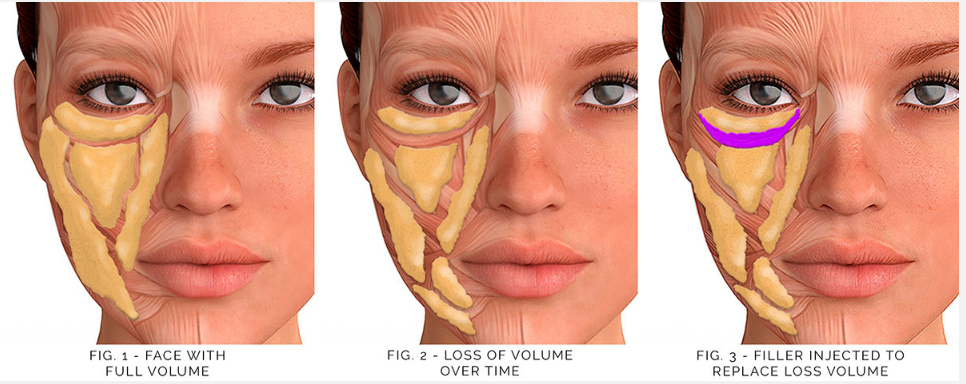
OVERFILLED TEAR TROUGH REGION/LUMPS AFTER TEAR TROUGH FILLER.
I am very unhappy with the results. I had tear trough filler a week ago. Filler was injected below my eyes; now I have lumps on both sides. One side is worse than the other. My eyes look like I have bags under them. Is this normal? What can I do about it?
Tear trough filler is a procedure that can help smooth the appearance of dark circles and bags under the eyes. However, there is always a risk of complications with any cosmetic procedure. In this case, the filler was injected too deep, resulting in lumps under the skin.
What is the tear trough area? The tear trough area is the indentation that runs from the corner of your eye to the top of your cheek. It is a common concern for many, as it can make you look tired and aged.
You may have a tear trough deformity for many reasons, including genetics, skin laxity, and volume loss. However, the good news is that many treatment options are available that will help improve the appearance of the tear trough area.
What can cause overfilling or lumps in the tear trough region? Several potential causes of overfilling or bumps in the tear trough region exist. One common cause is an excess of fat in this area. This can occur due to genetics or weight gain. Another potential cause is an accumulation of fluid in the tear trough area. This may be due to allergies, tear duct blockage, or eyelid surgery.
The tear trough area is the groove between the lower eyelid area and the cheek. Overfilling or many factors, including genetics, aging, environmental factors, and underlying medical conditions, can cause bumps in this area. How can you avoid overfilling or lumps in the tear trough area?
Genetics:
Genetics is one of the most common causes of overfilling or lumps in the tear trough area. Many people inherit this condition from their parents or grandparents.
Aging:
The natural aging process can cause overfilling or lumps in the tear trough area. The skin surrounding your eyes becomes thinner, more delicate, and sags as you age, which can cause the tear trough area to appear more pronounced.
Environmental factors:
Sun exposure, smoking, and other environmental factors can also contribute to overfilling or lumps in the tear trough area.
Underlying medical conditions:
In some cases, overfilling or lumps in the tear trough region may result from an underlying medical condition such as dehydration, allergies, or sinus problems.
What are the symptoms of overfilling or lumps in the tear trough area? The most common sign of filling or bumps in the tear trough area is the dark circles or bags under the eyes’ appearance. Other symptoms may include:
puffiness under the eyes
redness or inflammation under the eyes
soreness under the eyes
tenderness under the eyes
How are overfilling or lumps in the tear trough area diagnosed? Overfilling or bumps in the tear trough area were diagnosed during a physical examination. During your appointment, your doctor will review your medical history and symptoms and perform a physical exam. In some cases, additional testing may be necessary to diagnose or rule out other conditions.
How are overfilling or lumps in the tear trough area treated? No one-size-fits-all solutions exist for filling or bumps in the tear trough area. Treatment will depend on the underlying cause. Antihistamines or other medications may be prescribed if overfilling is due to allergies. If the reason is a sinus infection, antibiotics may be prescribed. If a cyst or tumor is present, it may need to be removed with surgery. In some cases, fillers or other cosmetic remedies may improve the area’s appearance.
You can do a few things if you have overfilled or lumpy tear troughs. First, you can massage the area gently with your fingertips. If that doesn’t work, try using a warm compress. If the overfill is severe, you may need to inject the area with hyaluronic acid.
AFTER FILLER; DISCOLORATION UNDER THE EYES
What is discoloration under the eyes after filler? The eyes are often one of the first places to show signs of aging. Our skin loses collagen and becomes thinner and more delicate, especially the fatty tissue that helps to support the eyes begins to break down. This can cause the eyes to appear sunken and tired-looking.
One way to resolve this issue is through dermal fillers. They are injected beneath the skin to reduce the appearance of wrinkles and creases and add volume. However, after dermal filler injections, patients sometimes notice slight discoloration under the eyes. This discoloration is usually temporary and should go away within a few weeks.
What are the causes of discoloration under the eyes after filler? There are many potential causes of discoloration under the eyes after fill, including:
– Allergic reaction to the filler
– Infection
– Hematoma
– Bruising
Many possible causes of discoloration under the eyes after filler includes bruising, inflammation, and infection. Bruising is the most common cause and usually resolves within a few weeks. Inflammation and infection are less common but more severe complications that may require treatment.
How can you treat discoloration under the eyes after filler? Discoloration under the eyes can occur after filler injections for various reasons. The most common cause is bruising when the filler is injected close to the skin’s surface. Other causes include trapped blood vessels or pigment changes.
Treating discoloration under the eyes after filler injections can be difficult, as the area is delicate and sensitive. The Tyndall effect can sometimes occur when the filler is injected into the skin. This is when the filler appears to be blueish under the skin.
The best course of action will vary depending on the cause of the discoloration. Treatments like bleaching creams or chemical peels may be necessary for pigment changes. For bruises, ice and gel can help swell reduce and speed up the healing process of trapped blood vessels; your doctor may recommend a laser treatment to break up the vessels.
When should you see a doctor for discoloration under the eyes after filler? This question is only possible to answer without knowing the extent of discoloration. If the discoloration is minor and does not cause pain or discomfort, it is likely nothing to worry about. However, if the discoloration is more severe or is accompanied by pain or swelling, consult a doctor as soon as possible.
Discoloration under the eyes after the filler is usually nothing to worry about. However, if you experience severe symptoms, it is best to see a doctor immediately.
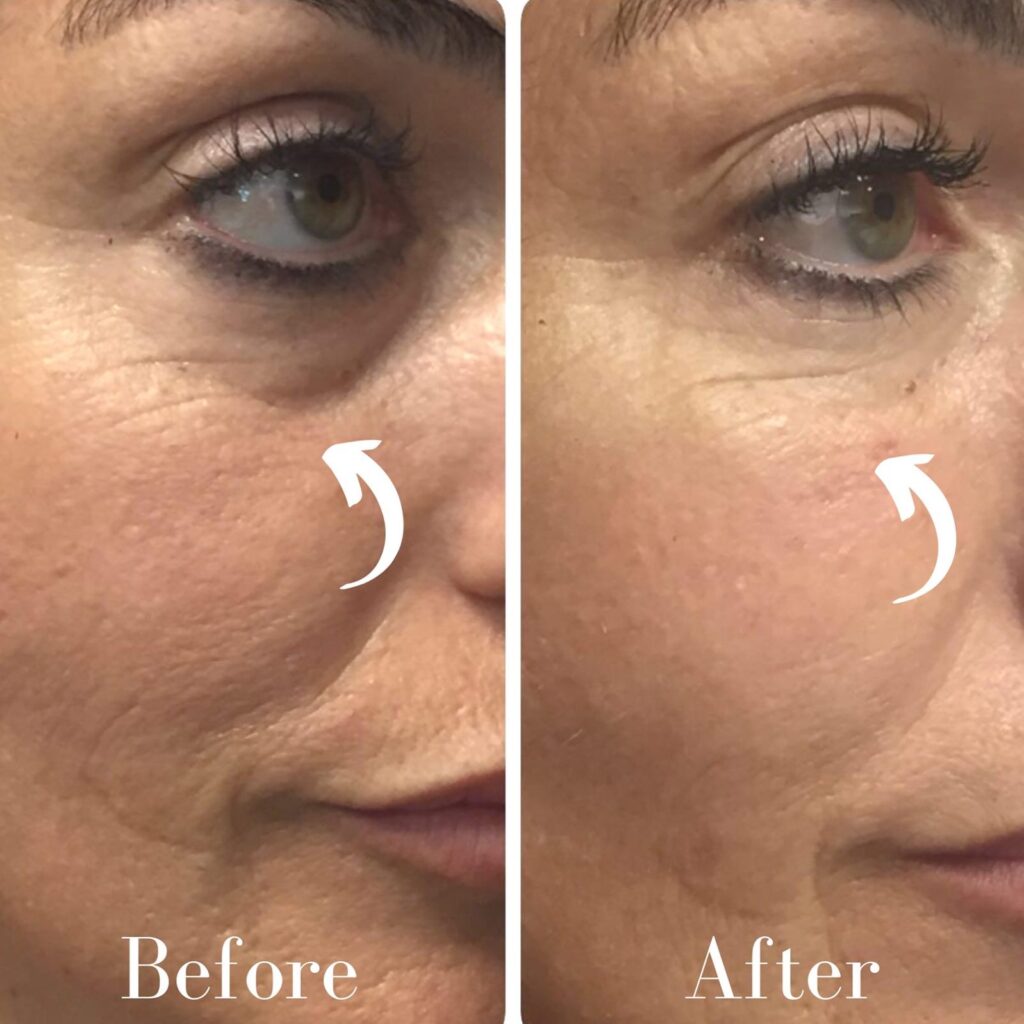
PATIENTS WHO HAVE DARK SKIN PIGMENTATION/NEED EYE FILLERS FOR DARK CIRCLES
Many people have been diagnosed with medical conditions recently, and patients with dark skin pigmentation seek eye fillers for dark circles. While the reasons for this are not fully understood, it is believed that the increased awareness of
the importance of eye bag removal surgery among dark-skinned patients may be a contributing factor.
Consider getting eye bag removal surgery for dark skin pigmentation. First, it is vital to find a surgeon experienced in performing surgery on patients with dark skin. Second, you should have a slightly higher volume of filler injected into the tear trough area to achieve the desired result.
1. Patients with dark skin seeking eye fillers.
A recent study found that patients with dark skin are more likely to seek out fillers for their eyes. The American Academy of Ophthalmology conducted the research and found that patients with dark skin were 2.5 times more likely to seek out fillers for their looks than patients with lighter skin.
This may be because dark-skinned patients are likelier to have dark circles under their eyes, which can be aesthetically displeasing. Fillers can help to mitigate the appearance of dark circles, giving patients a more refreshed and youthful look. can generally resolve with medical treatment. However, in rare cases, they can lead to permanent damage.
4. Factors to consider before getting fillers for dark circles.
Medical grade fillers are commonly used to diminish the appearance of dark under-eye circles. But before you book an appointment, you should consider a few factors.
First, it’s essential to understand that not all fillers are created equal. There are different types of stuffing with other properties, so it’s vital to consult a board-certified plastic surgeon or dermatologist to find out which filler is best for you.
Second, it’s also important to understand that fillers are temporary solutions. The results of fillers typically last 6 to 12 months, so you should be prepared to repeat the treatment every few months to maintain the results. Lastly, fillers can also be costly, so you should be ready to budget for the remedy if you consider getting fillers to help with dark circles.
5. How to find a reputable practitioner for dark circles fillers.
If you are considering dark circles fillers, it is vital to find a reputable practitioner. This decision should be taken seriously, as fillers can have serious side effects if done correctly.
There are a few key things on how to find a reputable practitioner for dark circles fillers:
1. Friends and family. Ask your friends and family if they know anyone who does dark circles fillers. If someone you know and trust has had a good experience with a practitioner, they are likely to be reputable.
2. Online reviews. Check online review sites such as Google and Yelp to see what others have said about practitioners in your area.
3. Before and after photos. Always ask to see before and after pictures of a practitioner’s work. This will give you an understanding of their skill level and what to expect.
4. Consultation. Schedule a consultation with a practitioner to discuss your goals and concerns. This will also allow you to see if you are compatible with each other.
5. Certification. Ensure the practitioner is certified by a qualified organization, such as the American Board of Cosmetic Surgery.
6. Experience. Ask the practitioner about their experience performing dark circles fillers. The more experience, the better to find a reputable practitioner for dark circles fillers.
PATIENTS WITH EXCESS SKIN AND HEAVY UNDER-EYE BAGS
Excess skin and plump under eye bags can be a nuisance for patients. Not only can they be aesthetically unappealing, but they can also cause physical discomfort. Excess skin can trap sweat and dirt, leading to skin irritation and infection. Heavy under-eye bags can cause headaches and neck pain.
Fortunately, treatments are available for patients with excess skin and heavy under-eye bags. Skin removal surgery can help eliminate excess skin, and fillers can help plump under eye bags.
What are the causes of excess skin and under eye bags?
It’s common to see people with excess skin and under eye bags. While this may be due to genetics or aging, several lifestyle factors can contribute to this problem.
For example, your skin will become less elastic and more prone to sagging if you don’t sleep enough. Additionally, if
you smoke cigarettes or drink alcohol regularly, this can also lead to excess skin and under-eye bags.
Fortunately, you can do several things to help you reduce the appearance of excess skin and under eye bags. Getting enough sleep and drinking plenty of water are two of the best things you can do. You can also use creams or hyaluronic acid serums to help plump the skin.
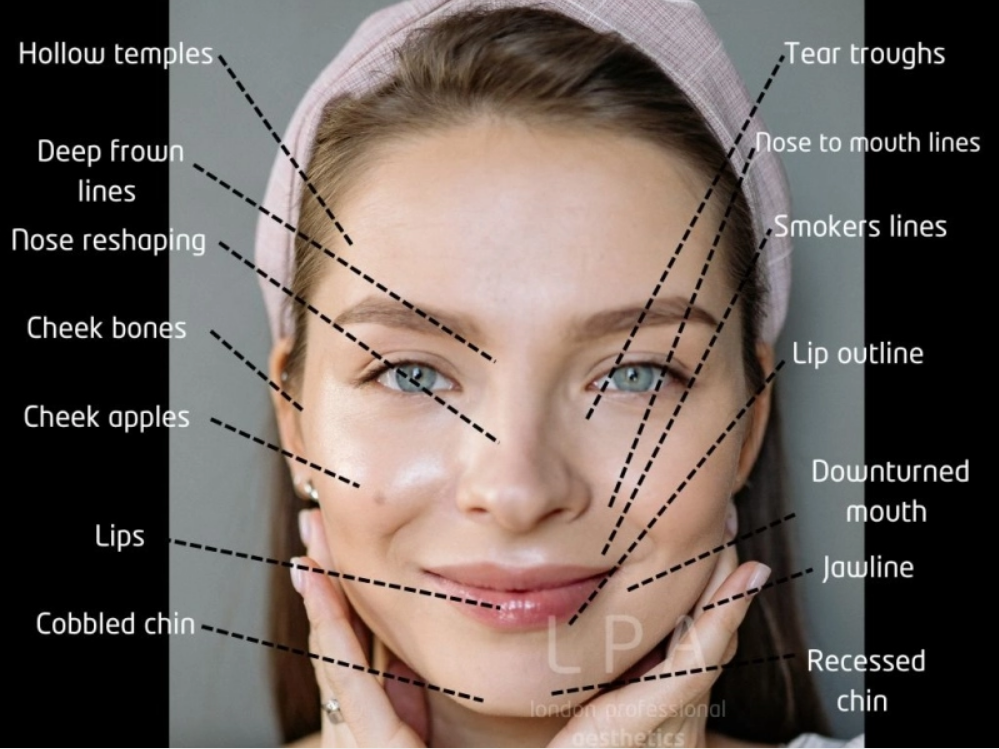
How can these be treated?
Excess skin and under-eye bags are two common problems affecting your appearance. You look older than you are, and it can be challenging to get rid of.
There are many treatments available for excess skin and under-eye bags. These include surgery, laser treatment, and fillers. However, these treatments can be expensive and unsuitable for everyone.
This article will examine more common treatment options for excess skin and under-eye bags. We will also discuss some factors you should consider before choosing a treatment.
Treatment options:
Surgery.
One of the most common treatments for excess skin and under-eye bags is surgery. This can involve either an upper or lower eyelid lift (blepharoplasty).
The surgery requires making an incision in the natural crease of the eyelid. After removing excess skin and fat, the incisions are closed with stitches.
The surgery can be a daunting experience performed under local or general anesthesia. The surgery usually takes around one to two hours to complete.
After the surgery, you must take painkillers and use cold compresses to reduce swelling. The stitches will be removed after five to seven days.
It is important to note that surgery is not suitable for everyone. For example, it is unsuitable for people with certain medical conditions, such as diabetes or high blood pressure. It is also unsuitable for pregnant women or people with recent eye surgery.
Laser treatment.
Laser treatment can be used to treat excess skin and wrinkles. The laser uses heat to tighten the skin. It’s also used to remove small areas of fat.
Laser treatment can be performed under local or general anesthesia. It is usually not painful, and the side effects are generally mild. The treatment usually takes around one to two hours to complete.After the treatment, you may have some swelling and bruising. The side effects usually last for around seven to 10 days.
Laser treatment is only suitable for some. For example, it is unsuitable for people with certain medical conditions, such as diabetes or high blood pressure. It is also unsuitable for pregnant women or people with recent eye surgery.
Dermal fillers.
Dermal fillers are also used to treat wrinkles and excess skin. The fillers are injected into the skin to plump it up. Dermal fillers can be performed under local or general anesthesia. It is usually not painful, and the side effects are generally mild.
The treatment usually takes around 30 minutes to one hour to complete. After the treatment, you may have some swelling and bruising. The side effects usually last for around seven to 10 days.
Dermal fillers are not suitable for everyone. For example, they are not ideal for people with diabetes or high blood pressure and patients with certain medical conditions. They are also not suitable for pregnant women.
Facelift.
A facelift can be used to treat wrinkles and excess skin. The surgery involves making incisions in the skin and lifting the underlying tissues. A facelift can be performed under local or general anesthesia. It is usually painful; the side effects can include swelling, bruising, and infection.
The surgery usually takes around two to four hours to complete. After the surgery, you must stay in the hospital for three to five days. The side effects usually last for about six to eight weeks. A facelift is only suitable for some.
A facelift can provide long-lasting results for around ten years. For example, it is unsuitable for people with certain medical conditions, such as diabetes or high blood pressure. It is also not suitable for pregnant women.
The benefits of treating excess skin and under eye bags.
There are several benefits to consider if you are considering treatment for excess skin or under-eye bags.
Firstly, treatment can help to improve your appearance. This can boost your confidence and self-esteem. Secondly, treatment can help to reduce any pain or discomfort you may be experiencing. This can make everyday activities, such as applying makeup or contact lenses, much more accessible.
Finally, treatment can also help prevent further damage to the skin. This reduces the risk of infection and other complications. Patients with excess skin or heavy under-eye bags may be candidates for surgery and can be helped by
blepharoplasty, a surgery to remove excess skin. This will help improve the eye’s appearance and make the patient look more rested and refreshed.